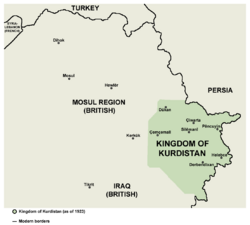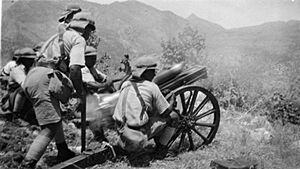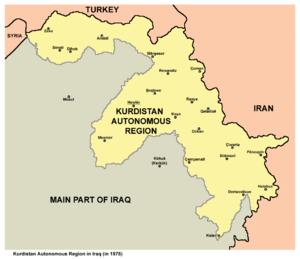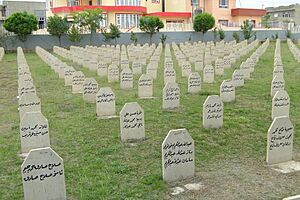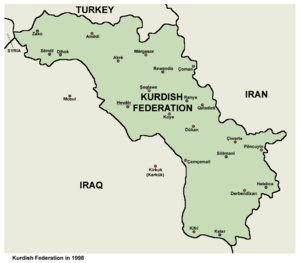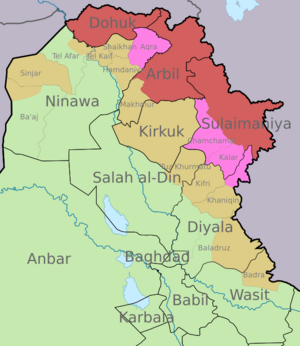Iraqi Kurdistan facts for kids
Iraqi Kurdistan is a special area in northern Iraq where many Kurdish-speaking people live. It's also called Southern Kurdistan by some. People who support Kurdish nationalism see Iraqi Kurdistan as part of a larger region called Greater Kurdistan, which also includes parts of Turkey, Syria, and Iran.
Most of Iraqi Kurdistan is part of the Kurdistan Region, which is a semi-self-governing area within Iraq. Some parts of Iraqi Kurdistan are not yet fully part of the Kurdistan Region and are called "disputed territories". There's a rule in the Iraqi constitution (Article 140) that was supposed to help solve these disagreements, but it hasn't been fully put into action yet.
Like other parts of Kurdistan, this region is mostly inland and has many mountains, which is different from most of Iraq.
Contents
What does "Kurdistan" mean?
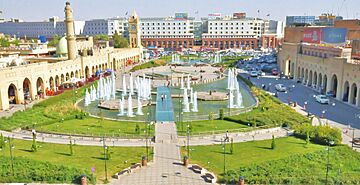
The exact meaning of the name Kurd isn't fully known. The ending -stan is an old word from Iranian languages that means "region" or "land". So, Kurdistan literally means "Land of the Kurds".
In the past, the name was sometimes spelled Curdistan. One very old name for this region was Corduene.
Geography and Nature
Iraqi Kurdistan is a very mountainous place. Its highest point is called Cheekha Dar, which is about 3,611 meters (11,847 feet) tall. Important mountains here include the Zagros, Sinjar Mountains, and Qandil mountains.
Many rivers flow through the region, making the land fertile and green. The Great Zab and Little Zab rivers are two important ones. The Tigris river also enters Iraqi Kurdistan from Turkey.
The mountains, different temperatures, and many rivers and lakes make Iraqi Kurdistan a great place for farming and tourism. The biggest lake is Lake Dukan. There are also smaller lakes like Darbandikhan Lake. The western and southern parts of the region have rolling hills and plains, not as many mountains.
Weather and Climate
Iraqi Kurdistan is generally cooler and wetter than the rest of Iraq because of its location and mountains. Most areas have a Mediterranean climate, which means they have hot, dry summers and mild, wet winters. Some southwestern areas are more semi-arid (drier).
In summer, average temperatures can range from about 35°C (95°F) in cooler northern areas to a very hot 40°C (104°F) in the southwest. Nights are cooler, around 21°C (70°F) to 24°C (75°F).
Winters are much cooler than in other parts of Iraq. Highs are usually between 9°C (48°F) and 11°C (52°F). Lows can be around 3°C (37°F) in some places and even drop below freezing (0°C or 32°F) in others, sometimes reaching -2°C (28°F).
Places like Soran, Shaqlawa, and Halabja also get very cold winters. Duhok has the hottest summers in the region, with average highs around 42°C (108°F).
The amount of rain changes across Iraqi Kurdistan. Some places like Erbil get about 500 mm (20 inches) of rain each year, while places like Amadiya can get up to 900 mm (35 inches). Most of the rain falls in winter and spring and is usually heavy. Summers and early autumns are very dry. Snowfall happens sometimes in winter, and frost is common.
Economy
The areas of Duhok, Erbil, and Sulaymaniyah have rich farmland. Farmers grow wheat and other grains there. Most farms rely on rainfall, but some smaller irrigation systems help water the crops.
Tourism is also growing in the Kurdistan Region. In 2014, Erbil was even named the "Tourism Capital" by the Arab Council of Tourism.
History of Iraqi Kurdistan
Ancient Times
The region of Iraqi Kurdistan has a very long history. In ancient times, people lived in places like the Shanidar Cave. Later, cultures like the Jarmo culture (around 7000 BCE) and the Hassuna culture (around 6000 BCE) developed here.
Over thousands of years, many different groups and empires ruled this land. These included the Gutians, Lullubi, Amorites, and Mitannians. Later, the Assyrians took control, and cities like Erbil became important centers.
Around the 7th century BCE, the Medes conquered the region, followed by the Achaemenids. Then, Alexander The Great took over in 332 BC. After him, the Greek Seleucid Empire and later the Parthians ruled. The region was also home to smaller, semi-independent kingdoms. By the 4th century AD, it became part of the Sassanian Empire. Christianity also spread in the region during this time.
Islamic Era and Ottoman Rule
In the mid-7th century AD, Arab Muslims conquered the region as they expanded their empire. Iraqi Kurdistan became part of large Muslim caliphates like the Rashidun, Umayyad, and Abbasid empires. After these, various Iranian, Turkic, and Mongol rulers took control.
From the 16th to the 17th century, the area was often fought over by the powerful Safavid Empire (from Iran) and the Ottoman Empire (from Turkey). Eventually, the Ottomans gained firm control in the mid-17th century. Ottoman rule lasted until World War I, when the British defeated them.
Kurdish Uprisings and British Control
After World War I, the British and French divided up parts of the Middle East. The British were given control over what would become Iraq.
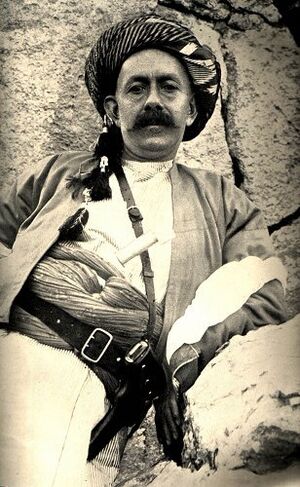
In 1922, the British tried to work with a Kurdish leader named Shaikh Mahmud Barzanji. They hoped he would help protect them from the Turks. But Shaikh Mahmud declared a "Kingdom of Kurdistan" and made himself king, challenging the British. It took the British two years to regain control.
Shaikh Mahmud led another uprising in 1930, which was also put down by British forces. Around this time, the Barzani clan also became strong supporters of Kurdish rights. In 1931, Ahmed Barzani led another rebellion, which helped inspire future Kurdish leaders like Mustafa Barzani.
During World War II, Mustafa Barzani led a rebellion that gave Kurds control of their areas until 1945. But with British help, the Iraqi government took back control, and Mustafa Barzani had to go into exile.
Struggle for Autonomy (1960s-1970s)
After a military coup in Iraq in 1958, Mustafa Barzani returned from exile. He was promised regional self-rule for the Kurds in exchange for his support. Barzani became the head of the Kurdistan Democratic Party (KDP). However, the Iraqi government didn't keep its promise of autonomy.

In 1961, the Kurdish revolt began when an Iraqi army group was attacked. The Iraqi Air Force bombed Kurdish villages, which made more Kurds join Barzani. The Iraqi government struggled to stop the uprising. This led to changes in the Iraqi government.
After more fighting, a ceasefire was declared in 1964. In 1966, Kurdish forces led by Barzani won a major battle against the Iraqi Army at Mount Handrin. This led to a peace plan in March 1970, which promised more Kurdish self-rule and representation in the government. However, the Iraqi government also started a program to move Arabs into oil-rich Kurdish areas like Kirkuk.
The Algiers Agreement and Its Impact
In 1973, the US secretly helped fund Kurdish rebels against Iraq. But in 1975, Iran and Iraq made a deal called the Algiers Pact. This agreement meant Iran stopped supporting the Kurds, leaving them without help. The rebellion ended, and many Kurds, including Barzani, went to Iran.
After this, the Iraqi government took full control of the northern region. They continued their "Arabization" program, moving Arab families into Kurdish, Turkmen, and Christian areas, especially around oil fields like Kirkuk. This caused more conflict, and in 1978-1979, many Kurdish villages were destroyed, and around 200,000 Kurds were forced to move.
The Anfal Campaign

During the Iran–Iraq War (1980-1988), the Iraqi government carried out very harsh actions against the Kurds. The Anfal campaign (1987-1989) was a terrible period where the Iraqi army, under Saddam Hussein, attacked Kurdish people. This campaign involved the widespread use of chemical weapons, which killed thousands of people, especially in the Halabja chemical attack. Around 2,000 villages were destroyed, and many Kurds were killed or forced to leave their homes. The large Kurdish town of Qala Dizeh was completely destroyed. This was a systematic effort to harm the Kurdish people.
Self-Rule After the Gulf War
After the Persian Gulf War in 1991, there was an uprising against Saddam Hussein. The United Nations Security Council Resolution 688 created a "safe haven" for Kurdish refugees, and the US and its allies set up a No-Fly Zone over northern Iraq.
In October 1991, the Iraqi government completely pulled its military out of the region. This allowed Iraqi Kurdistan to become largely independent in practice. The region was then governed by two main Kurdish parties: the Kurdistan Democratic Party (KDP) and the Patriotic Union of Kurdistan (PUK). Iraqi Kurdistan also got its own flag and anthem.
However, Iraq imposed an economic blockade on the region, making life hard. The two main parties also had conflicts over trade routes and resources. In 1998, with help from the United States, the KDP and PUK agreed to a ceasefire.
During and After the US-Led Invasion
Iraqi Kurds played a big part in the Iraq War in 2003, helping to overthrow the Iraqi government. Kurdish military forces, called Peshmerga, were very important.
In 2005, Iraq created a new constitution that made it a federal state with different Regions. The Kurdistan Region includes the areas of Erbil, Sulaymaniyah, and Duhok. This constitution recognized the Kurdistan Region and its laws since 1992.
Jalal Talabani, a PUK leader, became the President of Iraq, and Masoud Barzani, the KDP leader, became President of the Kurdistan Regional Government.
Recent Challenges
After the US military left Iraq, tensions grew between Iraqi Kurdistan and the central Iraqi government. They disagreed about sharing power, oil production, and control over certain areas.
In 2014, during the fight against ISIL (a terrorist group), Iraqi Kurdistan took control of the city of Kirkuk and other disputed areas. Masoud Barzani then announced that Iraqi Kurds would hold a vote on independence.
In September 2017, the 2017 Kurdistan Region independence referendum took place, and 92.73% of people voted for independence. However, this led to a military operation where the Iraqi government took back control of Kirkuk and other areas. The Kurdistan Regional Government had to cancel the referendum results.
Since then, the Iraqi government has taken steps that some Kurdish officials see as trying to reduce the Kurdistan Region's self-rule. In September 2023, the prime minister of the Kurdistan Regional Government, Masrour Barzani, asked the United States for help, warning that the Kurdistan Region's self-governing status might be at risk.
Culture
Newroz is a very important celebration for Kurdish people. It's their new year, celebrated on March 21st, which is also the first day of spring. Kurdish culture has been shaped by many ancient peoples, but it is most similar to Persian culture.
See also
- Disputed territories of Northern Iraq
- Turkish Kurdistan
- Syrian Kurdistan
- Iranian Kurdistan
Images for kids






